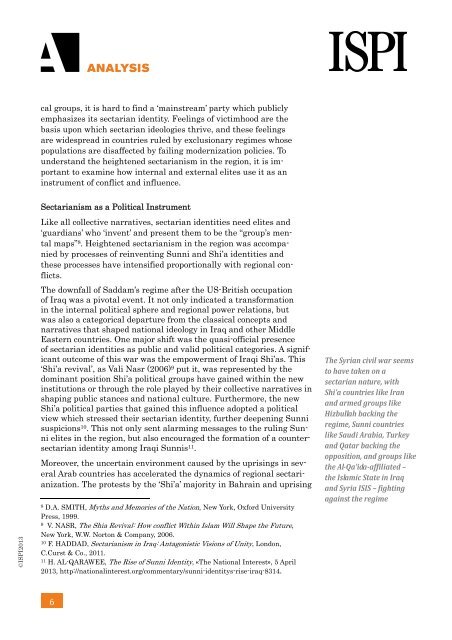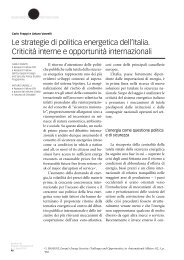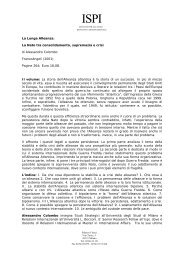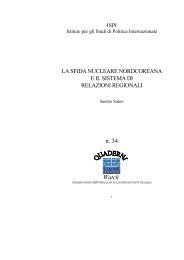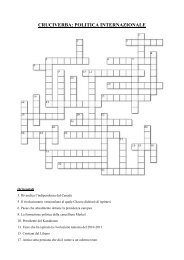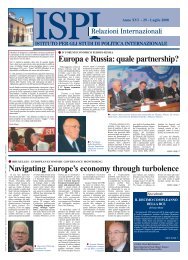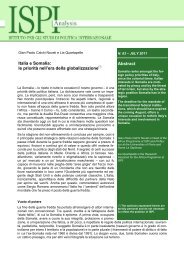heightened sectarianism in the middle east: causes, dynamics ... - Ispi
heightened sectarianism in the middle east: causes, dynamics ... - Ispi
heightened sectarianism in the middle east: causes, dynamics ... - Ispi
You also want an ePaper? Increase the reach of your titles
YUMPU automatically turns print PDFs into web optimized ePapers that Google loves.
cal groups, it is hard to f<strong>in</strong>d a ‘ma<strong>in</strong>stream’ party which publiclyemphasizes its sectarian identity. Feel<strong>in</strong>gs of victimhood are <strong>the</strong>basis upon which sectarian ideologies thrive, and <strong>the</strong>se feel<strong>in</strong>gsare widespread <strong>in</strong> countries ruled by exclusionary regimes whosepopulations are disaffected by fail<strong>in</strong>g modernization policies. Tounderstand <strong>the</strong> <strong>heightened</strong> <strong>sectarianism</strong> <strong>in</strong> <strong>the</strong> region, it is importantto exam<strong>in</strong>e how <strong>in</strong>ternal and external elites use it as an<strong>in</strong>strument of conflict and <strong>in</strong>fluence.©ISPI2013Sectarianism as a Political InstrumentLike all collective narratives, sectarian identities need elites and‘guardians’ who ‘<strong>in</strong>vent’ and present <strong>the</strong>m to be <strong>the</strong> “group’s mentalmaps” 8 . Heightened <strong>sectarianism</strong> <strong>in</strong> <strong>the</strong> region was accompaniedby processes of re<strong>in</strong>vent<strong>in</strong>g Sunni and Shi’a identities and<strong>the</strong>se processes have <strong>in</strong>tensified proportionally with regional conflicts.The downfall of Saddam’s regime after <strong>the</strong> US-British occupationof Iraq was a pivotal event. It not only <strong>in</strong>dicated a transformation<strong>in</strong> <strong>the</strong> <strong>in</strong>ternal political sphere and regional power relations, butwas also a categorical departure from <strong>the</strong> classical concepts andnarratives that shaped national ideology <strong>in</strong> Iraq and o<strong>the</strong>r MiddleEastern countries. One major shift was <strong>the</strong> quasi-official presenceof sectarian identities as public and valid political categories. A significantoutcome of this war was <strong>the</strong> empowerment of Iraqi Shi’as. This‘Shi’a revival’, as Vali Nasr (2006) 9 put it, was represented by <strong>the</strong>dom<strong>in</strong>ant position Shi’a political groups have ga<strong>in</strong>ed with<strong>in</strong> <strong>the</strong> new<strong>in</strong>stitutions or through <strong>the</strong> role played by <strong>the</strong>ir collective narratives <strong>in</strong>shap<strong>in</strong>g public stances and national culture. Fur<strong>the</strong>rmore, <strong>the</strong> newShi’a political parties that ga<strong>in</strong>ed this <strong>in</strong>fluence adopted a politicalview which stressed <strong>the</strong>ir sectarian identity, fur<strong>the</strong>r deepen<strong>in</strong>g Sunnisuspicions 10 . This not only sent alarm<strong>in</strong>g messages to <strong>the</strong> rul<strong>in</strong>g Sunnielites <strong>in</strong> <strong>the</strong> region, but also encouraged <strong>the</strong> formation of a countersectarianidentity among Iraqi Sunnis 11 .Moreover, <strong>the</strong> uncerta<strong>in</strong> environment caused by <strong>the</strong> upris<strong>in</strong>gs <strong>in</strong> severalArab countries has accelerated <strong>the</strong> <strong>dynamics</strong> of regional sectarianization.The protests by <strong>the</strong> ‘Shi’a’ majority <strong>in</strong> Bahra<strong>in</strong> and upris<strong>in</strong>g8D.A. SMITH, Myths and Memories of <strong>the</strong> Nation, New York, Oxford UniversityPress, 1999.9V. NASR, The Shia Revival: How conflict With<strong>in</strong> Islam Will Shape <strong>the</strong> Future,New York, W.W. Norton & Company, 2006.10F. HADDAD, Sectarianism <strong>in</strong> Iraq: Antagonistic Visions of Unity, London,C.Curst & Co., 2011.11H. AL-QARAWEE, The Rise of Sunni Identity, «The National Interest», 5 April2013, http://national<strong>in</strong>terest.org/commentary/sunni-identitys-rise-iraq-8314.The Syrian civil war seemsto have taken on asectarian nature, withShi’a countries like Iranand armed groups likeHizbullah back<strong>in</strong>g <strong>the</strong>regime, Sunni countrieslike Saudi Arabia, Turkeyand Qatar back<strong>in</strong>g <strong>the</strong>opposition, and groups like<strong>the</strong> Al‐Qa’ida‐affiliated –<strong>the</strong> Islamic State <strong>in</strong> Iraqand Syria ISIS – fight<strong>in</strong>gaga<strong>in</strong>st <strong>the</strong> regime6


